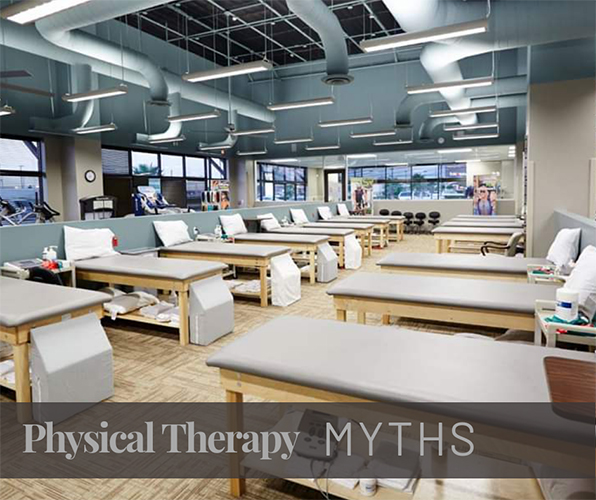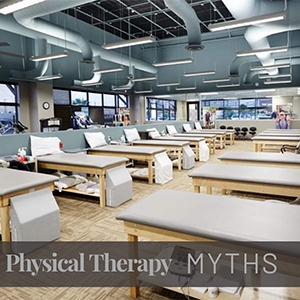
October is National Physical Therapy Month! Patients are sometimes under the misconception that PT is “pain and torture.” Physical Therapists and Physical Therapist Assistants are actually in the business of reducing pain. Although this misconception about PT is one of the most common, there are other myths out there as well. This blog is meant to shed some light on some common myths about rehabilitation and hopefully reduce your anxiety if you are on your way to therapy for that sprained ankle or torn ACL!
1. No pain, no gain.
This may be the Number 1 misconception about exercise. Pain is indicative of an injury. Muscle soreness, muscle fatigue, and burning are normal and means that you are working the muscle. In some circumstances, pain is normal. For example, after surgery, including knee replacements and rotator cuff surgeries in the shoulder, pain is normal. However, when performing exercises, pain should be avoided.
2. The heavier the weight, the better.
A program of higher repetitions at a lower weight is best to build the appropriate muscles. Use 30 repetitions as a rule of thumb: After doing 30 repetitions of a specific exercise, you should be fatigued and unable to do more repetitions. If you are not fatigued, then you should go up in the weight. However, if you are struggling before 30 or if your form is compromised, you should go down in weight.
3. I don’t need to do my home exercise program. Coming into PT 2 or 3 times per week is sufficient enough.
Attending PT 2 days per week is great, but what are you doing on those other 5 days? If you are not doing any sort of exercise, then the gains you make during your PT sessions may be lost. The truth is that a daily home exercise program in combination with formal PT 2 to 3 times per week is the best way to maximize your recovery and get you back to your normal activities the quickest.
4. Heat is better than ice after I work out.
Although a sauna or hot tub after a workout sounds relaxing, ice is more beneficial. Heat is a vasodilator, which increases blood flow and inflammation. Ice is a vasoconstrictor, reducing blood flow, inflammation, and post work out soreness. After a PT session or any work out, DOMS (delayed onset muscle soreness) sometimes occurs later in the day or even a day later. To help reduce the effects of DOMS, ice is recommended. When in doubt, ice!
5. Stretching isn’t important.
Many overuse injuries, such as tendinitis and muscle strains, occur as a result of poor flexibility. Tight muscles restrict our ability to move properly. Daily stretching consisting of 3 sets of 30 second holds can loosen up muscles to allow for maximum performance.
These 5 are the most common myths, but there are others. If you have any concerns about attending physical therapy for your first time, or if you have been to rehab in the past but are now being referred to physical therapy for a new diagnosis, please call us. We can help answer your questions and work together to find a treatment plan that’s right for you!






